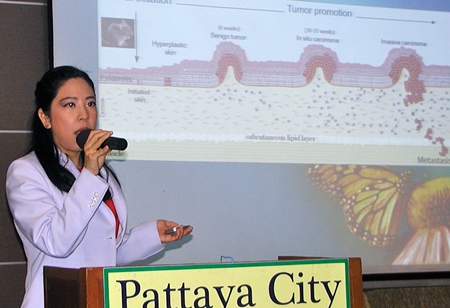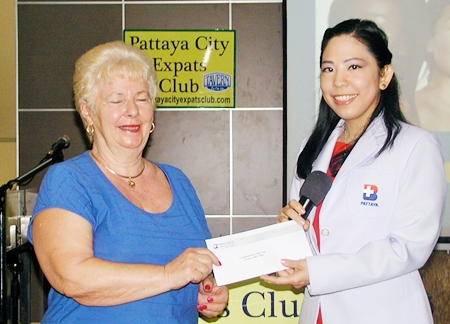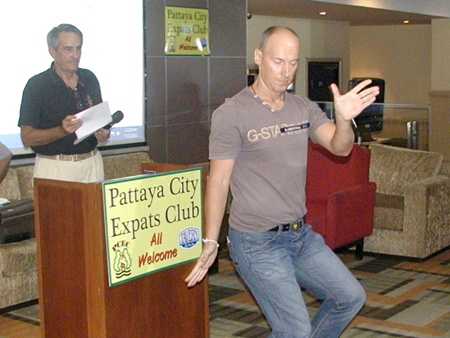Melanoma skin cancer is usually curable if it is recognised and treated early. But if left untreated, the cancer can spread to other parts of the body, where it becomes hard to treat and often can be fatal. This was one of the messages from Dr. Sureeporn Sritangrattanakul, a dermatologist at Bangkok Hospital Pattaya, who spoke to the Pattaya City Expats Club on Sunday, July 21.
Dr Sureeporn said that in her practice she sees many cases of skin cancer. Further, studies have shown that one in five Americans will develop skin cancer at some point during their lives. She also mentioned that the figures for other parts of the world are similar.
 MC Roy Albiston opens the 21st July meeting of Pattaya City Expats Club by inviting new members & guests to introduce themselves.
MC Roy Albiston opens the 21st July meeting of Pattaya City Expats Club by inviting new members & guests to introduce themselves.
Skin cancer comes in two forms: melanoma (which is malignant) and non-melanoma, which, while classified as a cancer, spreads much more slowly than the melanoma variety. Only 4-5% of skin cancers are melanoma, which is almost always curable when found and treated early. Although melanoma represents only a small portion of all skin cancers, Dr Sureeporn said, it accounts for 75% of skin cancer deaths. In the US, this translates into an estimated 8,790 deaths annually.
Non-melanoma skin cancer also comes in two forms: basal cell carcinoma (BCC), which is the more common of the two, and which affects the lowest layer of the skin; and squamous cell carcinoma (SCC), which affects the middle layer of the skin. Dr Sureeporn said that 40-50% of Americans who live to age 65 will have either BCC or SCC at least once; neither can evolve into melanoma.
Dr Sureeporn explained that skin cancer is the uncontrolled growth of abnormal skin cells. It occurs when there is DNA damage to skin cells that goes un-repaired. Further, that although the incidence of skin cancer is rising, the number of deaths from it is declining. The reason this is happening is because of better and earlier diagnosis and treatment.
The risk factors for skin cancer include (a) genetics (runs in the family); (b) having light skin; (c) exposure to the sun; (d) use of tanning salons; (e) having a weakened immune system; and (f) exposure to radiation. Dr Sureeporn said that living near the equator or at high altitudes also increases one’s risk of getting skin cancer. But the biggest risk factor, by far, is exposure to the sun. She also described actinic keratosis as pre-cancerous skin growths that could potentially evolve into squamous cell carcinoma and explained that it is caused by repeated and prolonged exposure to ultraviolet (UV) rays from the sun; it typically appears as rough spots on areas of the skin that have received sun exposure.
 Speaker for the meeting was Dr. Sureeporn Sritangrattanakul, a dermatologist at Bangkok Hospital Pattaya. She spoke about the risk of skin cancer, how to detect it, and how it is treated. With the slide Dr Sureeporn explained the tumour initiation process and how it progresses.
Speaker for the meeting was Dr. Sureeporn Sritangrattanakul, a dermatologist at Bangkok Hospital Pattaya. She spoke about the risk of skin cancer, how to detect it, and how it is treated. With the slide Dr Sureeporn explained the tumour initiation process and how it progresses.
Dr Sureeporn showed how one can distinguish melanoma from “ordinary” growths on the skin using the ABCD method, where A = Asymmetrical; B= uneven Borders; C = Colour variation; and D = a Diameter greater than 6mm. She said that the warning signs for squamous cell carcinoma include a persistent, scaly red patch with irregular borders that sometimes crusts or bleeds; an elevated growth with a central depression that occasionally bleeds; an open sore that bleeds, crusts and persists for weeks; and a wart-like growth that crusts and occasionally bleeds. A warning sign for skin cancer generally is an open sore that does not heal within two weeks.
 Alex from Australia was a lucky quiz winner, having known the answer to ‘which skin types are most susceptible to skin cancer?’
Alex from Australia was a lucky quiz winner, having known the answer to ‘which skin types are most susceptible to skin cancer?’
Dr Sureeporn said that she encourages her patients to do self-examinations of their skin. But because signs of skin cancer are often confused with normal skin conditions, people should see a dermatologist at least once a year for a check-up. Also, the most effective way to prevent skin cancer is to wear sunscreen with a sun protection factor (SPF) of 30 or more. Other preventive measures include staying out of the sun between 10 am and 4 pm when UV radiation from the sun is highest; wearing a hat and sunglasses; and covering your skin with clothes when the sun is the hottest.
 A demonstration and explanation of the origin and practice of Tai Chi by Alessandro Marmello then followed.
A demonstration and explanation of the origin and practice of Tai Chi by Alessandro Marmello then followed.
In response to questions from the audience, Dr Sureeporn said that one should still wear sunscreen on a cloudy day as UV rays penetrate clouds. Further, being under an umbrella at the beach does not offer complete protection because some sun rays may penetrate the umbrella; also UV rays can bounce off the sand and water. Dr Sureeporn noted that if you spend a lot of time driving, you should get appropriate coating for the windshield of the car or use sunscreen. Also, that even if you wear sunscreen, your body can still get enough sunlight to meets its Vitamin D needs.
After the presentation, Master of Ceremonies Roy Albiston updated everyone on upcoming events and then called on Jerry Dean to conduct the Open Forum, where questions are asked and answered and comments made about Expat living in Thailand.
To learn more about the Pattaya City Expats Club and its many activities, visit www.pattayacityexpatsclub.com.




